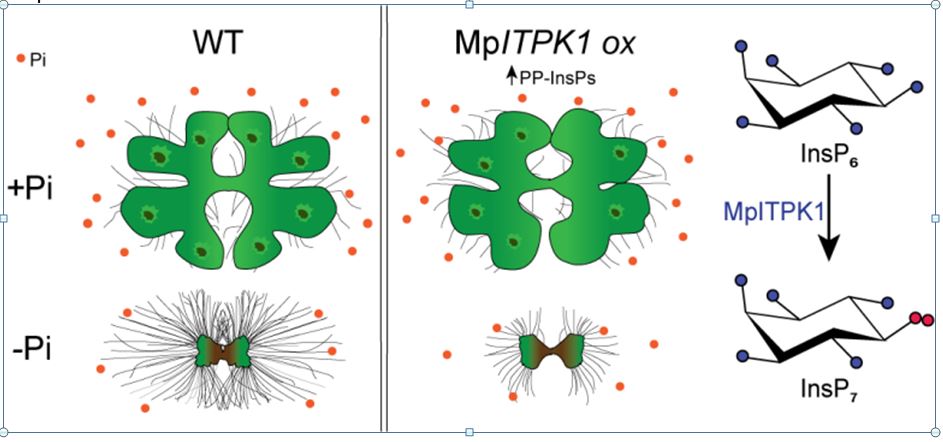How land plants have evolved in nutrient-limited environments

Role of inositol phosphates in phosphate homeostasis in Marchantia polymorpha (Image: Pullagurla Naga Jyothi)
Phosphorous is a crucial macronutrient that determines plant growth and yield. Despite its abundance in soil, phosphate is often fixed in soil and not readily available for plant absorption. Consequently, phosphate fertilizers are routinely used in agriculture. Since phosphate fertilizers are derived from definite phosphate rock, a major focus in modern agriculture to engineer crop species that can cope better with limited phosphate availability.
To survive under phosphate-limited environments, land plants exhibit remarkable developmental changes. Such adaptive responses are controlled by various cellular messengers. Inositol pyrophosphates (PP-InsPs), such as InsP7 and InsP8 are energy-rich nutrient messengers that control phosphate starvation responses in plants. Intriguingly, whether the regulation of phosphate homeostasis by PP-InsP is conserved across all land plants remained unknown until recently.
In a recent study published in Plant Physiology by the group of Debabrata Laha, Assistant Professor at the Department of Biochemistry, the researchers used the non-vascular bryophyte, Marchantia polymorpha, to study the functional conservation of phosphate homeostasis by PP-InsPs.
Under phosphate (Pi) starvation conditions, both male and female M. polymorpha plants undergo drastic developmental changes, including reduced thallus growth, accumulation of red pigment, and increased rhizoid density, according to the first author and PhD student Pullagurla Naga Jyothi.
In collaboration with Henning J Jessen, Professor at the University of Freiburg, Germany, the team demonstrated that cellular InsP and PP-InsP levels decreased sharply under limited phosphate conditions. Remarkably, the cellular levels of specific PP-InsP messengers such as 5-InsP7 and 1/3,5-InsP8 were recovered when phosphate was resupplied. This suggests that these specific PP-InsPs play a vital role in Pi homeostasis.
The researchers also characterised MpITPK1, one of the two inositol trisphosphate kinases (ITPK) found in the M. polymorpha genome. Through various assays, they showed that MpITPK1 phosphorylates InsP6 to produce InsP7. Next, they generated MpITPK1 overexpression plant lines that exhibited increased levels of 5-InsP7 and a specific InsP8 isomer. Interestingly, these M. polymorpha lines with augmented levels of PP-InsP species displayed altered adaptive responses under Pi starvation.
The study also revealed that M. polymorpha mutant lines lacking functional MpPHO1, a phosphate exporter, accumulate different PP-InsP isomers and show altered responses to low phosphate compared to wild-type plants. This finding provides an additional line of evidence about the role of PP-InsPs in phosphate sensing in M. polymorpha. The researchers conclude that the function of inositol pyrophosphates in regulating phosphate starvation responses is likely conserved in all land plants.
The Laha laboratory is currently investigating the precise molecular basis of inositol pyrophosphate-controlled phosphate homeostasis in diverse plant species.
REFERENCE:
Pullagurla NJ, Shome S, Liu G, Jessen HJ, Laha D, Orchestration of phosphate homeostasis by the ITPK1-type inositol phosphate kinase in the liverwort Marchantia polymorpha, Plant Physiology (2024). https://doi.org/10.1093/plphys/kiae454
LAB WEBSITE:
https://biochem.iisc.ac.in/debabrata-laha.php




